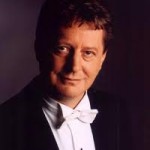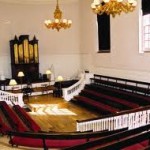 15 January
15 January
The New Year began on an educational note for the Brighton Philharmonic Orchestra. The day prior to the concert a large number of primary school children had gathered at the Dome for a rehearsal of Britten’s Young Person’s Guide to the Orchestra. Not only where they introduced to the orchestra but had a chance to conduct along with Barry Wordsworth. At a time when music education is under threat, this hugely enjoyable experience is to be treasured.
The concert the following day opened with the Four Sea Interludes from Peter Grimes. These have always worked well in the concert hall and the ringing brass for Sunday Morning was particularly effective. The storm thrashed around the Dome to thrilling effect.
In keeping with the educational theme, Mozart’s Sinfonia concertante K364 drew on young soloists from the Yehudi Menuhin School. Anna Lee was the polished and lyrical violinist, with Nazli Erdogan a warm and sensitive viola player. They proved very well matched and created a pleasing ensemble with the orchestra. The dark second movement Andante was particularly effective in its mood setting.
After the interval the tone was lightened with Britten’s Matinees Musicales before a compelling reading of the Young Person’s Guide. While the work is very familiar from its regular radio performances it is not, maybe, as often heard in the concert hall today. One too easily forgets just how demanding Britten’s writing is for the orchestra and it was a tribute to all involved that the outcome was as polished, svelte and enjoyable at often electrifying speeds.
29 January
There seems to have been something of a gypsy theme this season and it continued with two works by the virtuoso violinist Pablo de Sarasate. Not quite as well known today as his contemporaries Paganini and Joachim, his compositions are flamboyant and entrancing. The Zigeunerweisen is based on Hungarian melodies and allows the soloist to wallow in sentimental portamento which at times verges on the erotic. The Carmen Fantasy brings popular melodies but embellishes them in a way which almost goes beyond belief. There are times it is difficult to comprehend just how many notes you are hearing. Throughout all of this Vasko Vassilev played as if it were the most natural thing in the world. Not only is his technique flawless, but his personality shines through without any sense of pomposity or smugness. Performances of this magnitude are rare enough that they need to be snapped up and enjoyed while they are passing. How sad that some people in Brighton chose not to attend.
The afternoon had opened with a sprightly reading of the overture to Rossini’s William Tell and concluded with Charles Mackerras’ arrangement of Sullivan for Pineapple Poll. It is always interesting to hear Sullivan with a full symphony orchestra rather than the pit band which is normally provided. Not only does the scoring benefit from the additional weight of string sound but the brass sounds far more pertinent. Add to this Mackerras’ subtle re-orchestration and we are probably hearing Sullivan somewhat better than the composer intended.
Barry Wordsworth was on fine form throughout. This is rapidly becoming a vintage season.

12 February 2012
There is no problem with popularity but some programme planning can unfortunately serve to highlight the exceptional above the merely enjoyable.
Opening with Chabrier’s Espana was pleasant but by comparison to the closing fire and colour of Rimsky-Korsakov’s Capriccio Espagnol it all seemed rather tepid.
The same could be said of Rodrigo’s Concierto de Aranjuez where familiarity could not be effaced even by the splendidly adroit playing of guitarist Craig Ogden. He seemed far happier in the first performance in England of Nigel Westlake’s Shadow Dances for Guitar, where the heat and mirages of Australia shimmer effectively. A work which could easily drift impressionistically is actually securely structured around repeated phrases and ideas, even if only hinted at through internal rhythms. This keeps the listener focussed and makes the whole piece most impressive.
This, and a beautifully understated performance of Debussy’s Petite Suite –with some exceptional solo playing – proved to be the high point of the afternoon.
Barry Wordsworth allows his players not only to enjoy themselves but to communicate this easily to his audience.
25 March 2012
The final concert of the season brought together the heavy weights in more senses than one, though the opening Prelude de l’apres-midi d’un Faune offered a delightful bon bouche.
Pianist John Lill is President of the Brighton Philharmonic, and a very active supporter, particularly when in the thralls of Rachmaninov’s Third Piano Concerto. The opening movement held the dynamic balance in check, allowing the musical line a muscular fluidity, as if preparing for the explosion to come. Unfortunately the Intermezzo drifted rather at times, though this was more a problem with the scoring than with the perception of the performers. The finale galvanized itself with a light energy, which allowed for a more refined conclusion which was received with rapture by a very full Dome audience.
Berlioz’ Symphonie fantastique was the final work and showed both orchestra and conductor at their best. Barry Wordsworth trusts his players and allows them to develop musical lines without trying to over-manage them. This allowed for some particularly effective solo playing – the woodwind always in evidence, and the solo flute proving that the opening l’apres-midi was not a flash in the pan.
Barry Wordsworth’s approach was unusual. In theory the work gets darker and more nightmarish as it proceeds. He reversed this. The opening movements proved to be uncomfortably sinister, the dark drum rolls and empty landscapes bringing a sinister touch.
By contrast the March to the Scaffold and Witches’ Sabbath were positively jolly, with a riotous ending from the brass in full flow.
Next season has already been announced – details from www.brightonphil.org.uk – and it opens on 21 October with a Trafalgar Day concert of patriotic English music. Be there.
BH







 Renaissance Theatre Company, Phoenix Venue, Hastings 12 April 2012
Renaissance Theatre Company, Phoenix Venue, Hastings 12 April 2012
